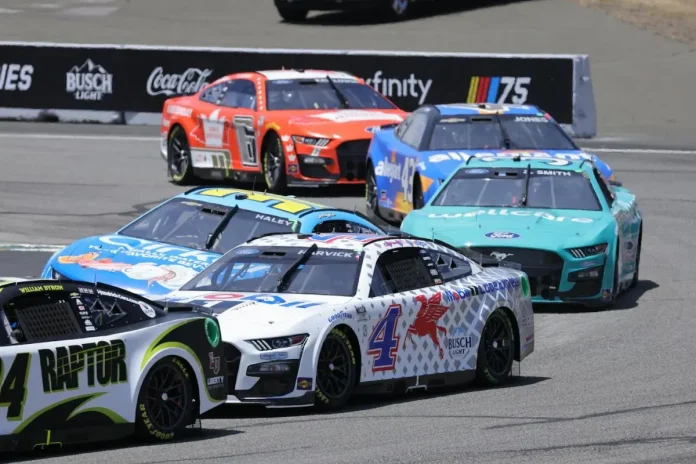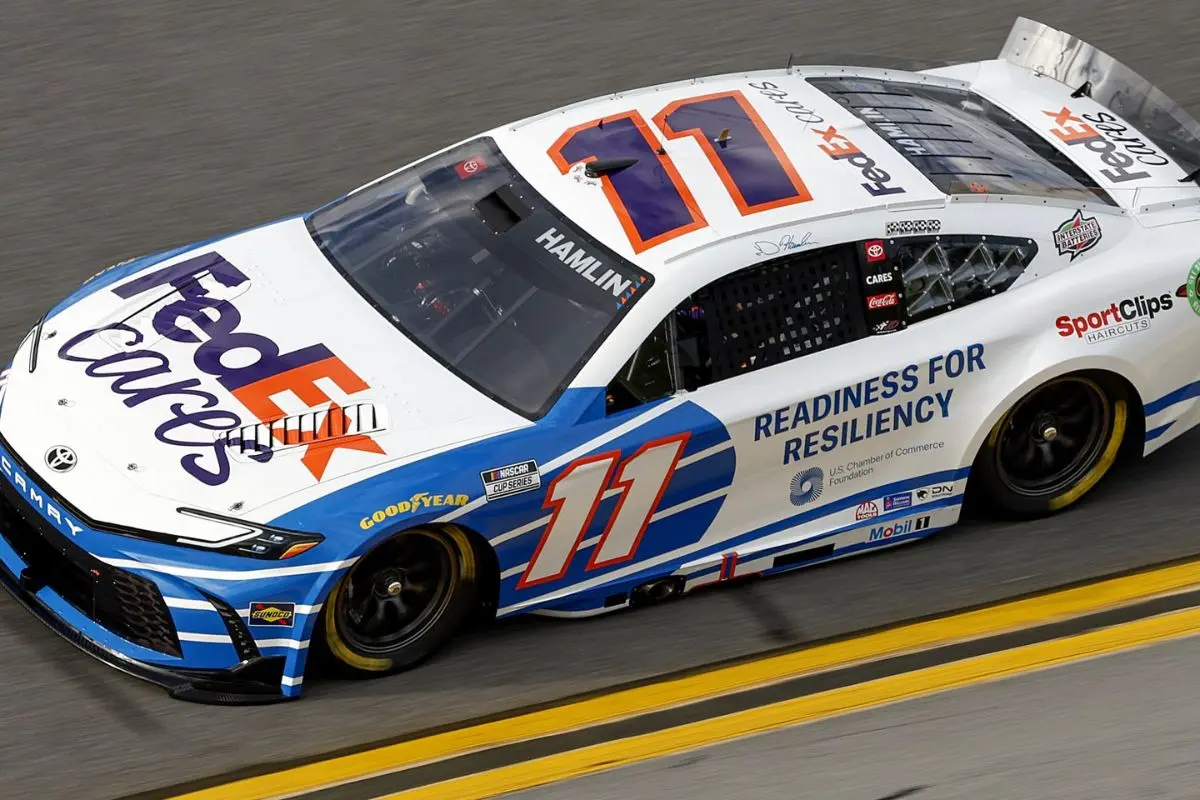Why NASCAR Pushed Car Numbers Forward: NASCAR’s decision to move car numbers forward on vehicle panels symbolizes a broader evolution towards improved sponsor visibility and financial sustainability. This shift reflects a modern marketing approach that prioritizes brand logos, thereby altering fan engagement once based heavily on iconic car numbers.
Key Highlights
- The numbers were pushed forward to enhance sponsorship visibility, optimizing exposure for primary sponsors on the car’s side panels.
- The shift reflects NASCAR’s evolving business model, prioritizing financial health through increased sponsor-centric car identification.
- Despite modern changes, NASCAR aims to balance innovation with preserving traditional elements and fan connection to the sport’s legacy.
- The move sparked mixed reactions, as NASCAR fans express concerns about diluting the historical significance of iconic car numbers.
- NASCAR’s future strategies involve integrating commercial imperatives with maintaining the sport’s heritage and identity.
The Legacy of NASCAR’s #11: A Number Steeped in History
Few numbers in the storied world of NASCAR carry as much weight and history as #11. With an impressive record of 234 wins, it stands as the most victorious and perhaps the luckiest number in the annals of the sport. This number has been etched into the memories of fans through the skill of legendary drivers such as Cale Yarborough, Ned Jarrett, and Darrell Waltrip. Their formidable performances on the track have not only brought glory to the number but also cemented its revered status within the NASCAR community.
The legacy of #11 is further enriched by its current association with Denny Hamlin, a driver who continues to uphold the winning tradition. For fans and drivers similarly, this number exemplifies a storied connection, transcending mere numerals to symbolize decades of racing excellence and shared victories. The emotional bond between drivers bearing #11 and their supporters is palpable, reflecting a heritage that resonates deeply within the sport’s culture.
Beyond its competitive success, #11 has become a representative figure in NASCAR’s narrative, representing continuity amidst the sport’s changing landscape. As the structure and aesthetics of NASCAR vehicles undergo transformation, the significance of iconic numbers like #11 remains a constant thread linking past, present, and future.
While the design of cars may change, the number’s enduring appeal is a reflection of its historical weight and its crucial role in shaping NASCAR’s identity. Consequently, #11 stands as a timeless symbol of racing legacy and fan allegiance.
The Experimental Shift: Moving the Number Backward
Innovation often challenges tradition, and such was the case with NASCAR’s experimental shift in car number placement during the 2020 All-Star race at Bristol. This notable alteration involved moving the number to the back half of the car’s side panel, a move exemplified by Chase Elliott’s winning #9 car. Designed to improve sponsorship visibility, this change also coincided with the introduction of an underglow feature, adding a modern flair to the race’s visual aesthetics.
Despite the intention of increasing sponsorship visibility, the experimental shift was met with resistance from numerous stakeholders. Joe Gibbs Racing President Dave Alpern highlighted the concerns raised by fans and partners, who felt that the traditional number placement was integral to NASCAR’s identity.
“NASCAR worked with the teams to move the numbers either backward or forward, quite a bit was down over social media to get fans’ input. Admittedly, a lot of fans wanted to keep the numbers in the same spot. We did a one-race experiment for the all-star race where we moved the number back. That didn’t go over as well with partners.”
“In 2022, when the next-gen car came out, the new car configuration had quite a bit less space on the quarter panel for primary sponsors…Ultimately we decided to move them forward. Which allows teams to use the door space for the primary sponsors. Much of which was lost in the quarter panel area with the configuration of the new car.” – Dave Alpern
The feedback indicated a deep-rooted connection between fans and the customary aesthetics of the sport, suggesting that such shifts could potentially disrupt the familiar visual language NASCAR enthusiasts have grown to love.
On this day in 2020, Chase Elliott won the All-Star race at Bristol! pic.twitter.com/mCm4Jsw5bS
— Nascarpixtures (@Nascarpixtures) July 15, 2024
Ultimately, the number placement reverted to its traditional position post-experiment, emphasizing the importance of balancing innovation with heritage.
While the experimental shift sparked conversation and brought temporary excitement, it also reinforced the need for thoughtful integration of change in a sport deeply rooted in tradition.
The NASCAR Next Gen Car and the Forward Shift of Numbers
The introduction of NASCAR’s Next Gen car marked a vital moment for the sport, as it prompted a forward shift in car numbers to accommodate new design constraints. Launched at the 2022 Daytona season opener, this radical redesign featured a smaller quarter panel, a change that necessitated rethinking the placement of primary sponsor logos. Traditionally occupying the door panel area, these logos now required extra space, leading to the tactical decision to move car numbers forward.
“So the teams decided to pull that space back to provide more value to our primary sponsors. It cleans up the look of the car and provides more for the sponsors, who are paying for the majority of the car to do with what they want.” – Dave Alpern
This adjustment was not merely a logistical response but a calculated action aimed at optimizing sponsor visibility. By shifting numbers towards the front, NASCAR opened up valuable real estate on the door panels, allowing teams to display their sponsors more prominently. Richard Childress Racing President Torrey Galida emphasized the advantages of this new configuration, noting its potential to improve sponsor branding.
This shift, while seemingly minor, holds substantial implications for commercial partnerships, as it offers sponsors a more visually impactful presence, potentially translating to greater returns on investment.
View this post on Instagram
Moreover, the alteration to the Next Gen car and the subsequent number realignment present teams with a unique opportunity to innovate creatively. With the newfound space, design teams can investigate novel aesthetic elements that both captivate fans and strengthen brand identity.
Despite initial hesitation from traditionalists, this development aligns with NASCAR’s broader objective of modernizing the sport while preserving its core appeal. Ultimately, the forward shift of numbers is a proof of NASCAR’s commitment to balancing tradition with progress, ensuring the sport’s relevance in a constantly changing landscape.

What Happened to Contingency Sponsors?
Many may wonder what became of the contingency sponsors who once occupied prime real estate on NASCAR vehicles. In the pre-Next Gen era, these sponsors, often suppliers of crucial parts or services, were prominently displayed on the front panels of cars. Brands like Monster and 3M benefited from this visibility, creating a symbiotic relationship with NASCAR teams.
However, the introduction of the Next Gen car brought considerable changes to the sponsorship landscape. The redesign necessitated a shift in the placement of car numbers, which, in turn, affected where contingency sponsor logos could be displayed. The new arrangement prioritizes space for primary sponsors, those who contribute the most considerable financial support to teams. This tactical move aims to enhance the exposure and value for these major investors while maintaining a sleek, modern look for the vehicles.
Key impacts of the shift include:
- Relocation of Logos: Contingency sponsors now find their logos moved to other areas, such as rear panels or less visible sections of the car.
- Improved Value for Major Sponsors: With prime real estate allocated to major sponsors, their investment yields greater visibility.
- Streamlined Aesthetic: The cleaner design appeals to modern viewers, aligning with broader trends in sports marketing.
- Potential Shift in Sponsorship Dynamics: Smaller sponsors may need to reassess their strategy and negotiate for different forms of exposure or support.
The Future of NASCAR Numbers and Sponsorships
As NASCAR navigates the future of its car numbers and sponsorship strategies, the sport faces a delicate balance between honoring its storied traditions and adapting to the commercial imperatives of modern sports marketing. The repositioning of car numbers to prioritize primary sponsors such as FedEx on Denny Hamlin’s vehicle exemplifies this shift. This transformation has made it easier for fans to recognize cars by their sponsors rather than solely by their numbers, reflecting a broader trend in sports marketing where brand visibility is paramount.
The challenge lies in maintaining the sport’s identity while embracing these changes. The traditional emphasis on numbers as iconic symbols in NASCAR history is juxtaposed with the commercial need for prominent sponsor placement. While the new arrangement has become standard, it remains a topic of debate among fans and teams.
Looking ahead, NASCAR’s strategy must involve a complex approach that respects both its heritage and the evolving dynamics of sponsorship. This involves fostering a symbiotic relationship between teams and sponsors, ensuring that fan engagement is not compromised. As the sport continues to investigate creative ways to integrate these elements, the debate over the impact on NASCAR’s legacy will certainly persist, driving passionate discussions among its devoted followers.
News in Brief: Why NASCAR Pushed Car Numbers Forward
The evolution of car number placement in NASCAR reflects the sport’s ongoing adaptation to technological advancements and commercial demands. By shifting numbers forward, NASCAR aligns itself with modern design aesthetics and improves sponsorship visibility, vital for financial sustainability. The change highlights the dynamic nature of NASCAR, balancing tradition with innovation. As the sport navigates this transformation, the interplay between historical legacy and contemporary needs will shape its identity and influence its future path in the competitive racing landscape.
ALSO READ: NASCAR’s Martinsville Penalty Leaves Christopher Bell Furious, Insider Explains the Fallout




Car numbers should NOT have moved it looks like SHIT. Who’s the moron that initiated this. Fire their asses. Don’t fuck with tradition.